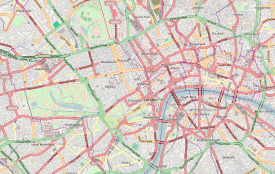| Palace of Whitehall | |
|---|---|
 The Old Palace of Whitehall by Hendrick Danckerts, c. 1675.[1] The view is from the west, in St. James's Park. The Horse Guards barracks are on the extreme left, with the taller Banqueting House behind it. The four-towered building left of centre is the palace gatehouse, the "Holbein Gate".[2] | |
| Location | City of Westminster, Middlesex, Kingdom of England |
| Coordinates | 51°30′16″N 00°07′32″W / 51.50444°N 0.12556°W |
| Built | c. 1240, 15–17th century |
| Demolished | 1698 (due to fire) |

The Palace of Whitehall – also spelled White Hall – at Westminster was the main residence of the English monarchs from 1530 until 1698, when most of its structures, with the notable exception of Inigo Jones's Banqueting House of 1622, were destroyed by fire. Henry VIII moved the royal residence to White Hall after the old royal apartments at the nearby Palace of Westminster were themselves destroyed by fire. Although the Whitehall palace has not survived, the area where it was located is still called Whitehall and has remained a centre of the British government.
White Hall was at one time the largest palace in Europe, with more than 1,500 rooms, before itself being overtaken by the expanding Palace of Versailles, which was to reach 2,400 rooms.[3] At its most expansive, the palace extended over much of the area bordered by Northumberland Avenue in the north; to Downing Street and nearly to Derby Gate in the south; and from roughly the elevations of the current buildings facing Horse Guards Road in the west, to the then banks of the River Thames in the east (the construction of Victoria Embankment has since reclaimed more land from the Thames)—a total of about 23 acres (9.3 ha). It was about 710 yards (650 m) from Westminster Abbey.
- ^ "Hendrick Danckerts". Government Art Collection. Archived from the original on 28 June 2018. Retrieved 4 January 2010.
- ^ The buildings are identified in a pictorial map of 1682 by William Morgan. Reproduced in Barker, Felix; Jackson, Peter (1990). The History of London in Maps. London: Barrie and Jenkins. pp. 42–43. ISBN 0-7126-3650-1.; the so-called "Holbein Gate" as it was known in the 18th century, though any connection with Hans Holbein was fanciful (John Summerson, Architecture in Britain 1530–1830, 9th ed. 1993: 32) survived the fire and was demolished in 1769.
- ^ "Whitehall". BBC. Archived from the original on 28 October 2004. Retrieved 15 August 2012.
